How and why to spray tomatoes with milk with iodine and boric acid: recipe and advice from experienced summer residents
Almost all summer residents grow tomatoes in their garden, despite the fact that the culture is often affected by pests and susceptible to diseases. Lossless harvest can be obtained by spraying tomatoes with milk with iodine and boric acid.
The method allows you to grow sweet and juicy tomatoes without the use of pesticides. We will tell you how to properly prepare and use the solution to get a crop without loss.
The content of the article
Why do tomatoes need this composition
Tomatoes need proper care. Organic feeding of tomatoes has a positive effect on growth, fruit set, and plant health. The drugs are used as fertilizer, used in the fight against diseases and pests.
What gives iodine to tomatoes
Vegetable growers use iodine as a means to fight diseases and pests. Due to its fungicidal properties, it improves nitrogen metabolism, replaces nitrate, and serves as an excellent fertilizer.
The benefits of this drug for tomatoes:
- The first assistant in the fight against fungal infections.
- It has a positive effect on the growth of seedlings.
- Plant immunity is strengthened.
- Flower clusters develop, the number of ovaries increases.
- The fruits ripen earlier and are filled with sucrose.
- Iodine deficiency is replenished. The lack of this substance weakens the growth of tomatoes, which causes immunity to suffer, plants are more sick.
Top dressing is carried out in three stages:
- The first time when the third and fourth leaves appear.
- The second is at the ovary stage. During this period, a solution is prepared at the rate of three drops of iodine per bucket of water, watered by a liter per bush.
- The third time is fertilized during the green fruit period.
Note. Only warm water is taken to dilute the solution.
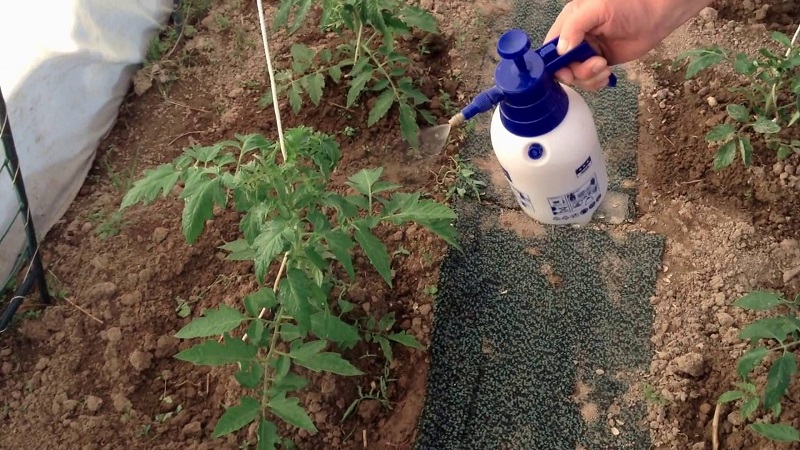
Milk
Raw milk contains macro- and microelements useful for plants. Among them are copper, iron, zinc, manganese, iodine, fluorine, selenium, lead, magnesium, phosphorus, sodium, calcium. It is an organic fertilizer and pest control.
Lactose and milk sugar, which are part of milk, repel insects. Milk adheres to plants and creates a thin film that prevents pathogenic bacteria from entering.
Attention. Pure milk cannot be used, it can negatively affect plants.
The solution is made in the proportion: 4 liters of water, 1 liter of milk, 15 drops of iodine. Plants are treated with milk mixture every two weeks throughout the summer season.
Boric acid
Boron is essential for the full development of tomatoes. With its help, plants assimilate useful substances, macro- and microelements from the soil.
Effects of boron on nightshade plants:
- promotes long flowering;
- increases the number of ovaries;
- regulates the consumption of moisture by the plant when the fruit ripens;
- accumulates sugar content in tomatoes;
- an effective means of combating fungal diseases and pests;
- used as organic fertilizer.
Tomatoes are fed in two ways:
- Top dressing under the root. A solution of boric acid is diluted with water in the proportion: 1 tbsp. spoon boron in a bucket of water. One liter is poured under the bush.
- For root fertilization, the solution is prepared in proportions as for root dressing. Plants are sprayed in the evening in calm weather.
Reference. Powder crystals are poured with hot water.
Foliar dressing is carried out three times per season:
- after planting seedlings in the ground, they are sprayed for the first time;
- the second time - before flowering;
- the third - during the period of green fruits.
Indications for use of the solution
The solution is used as a fertilizer, as well as a means of combating diseases and pests. When using the solution, it must be remembered that a lack of macro- and microelements is just as harmful as an excess. Use the product as directed so as not to harm the plants.
In what cases to use the solution:
- the tops of the bush are pale in color;
- growth points are not formed;
- the plant does not bloom;
- few inflorescences, or they fall off;
- fruits are not sugary;
- as prevention phytophthora.
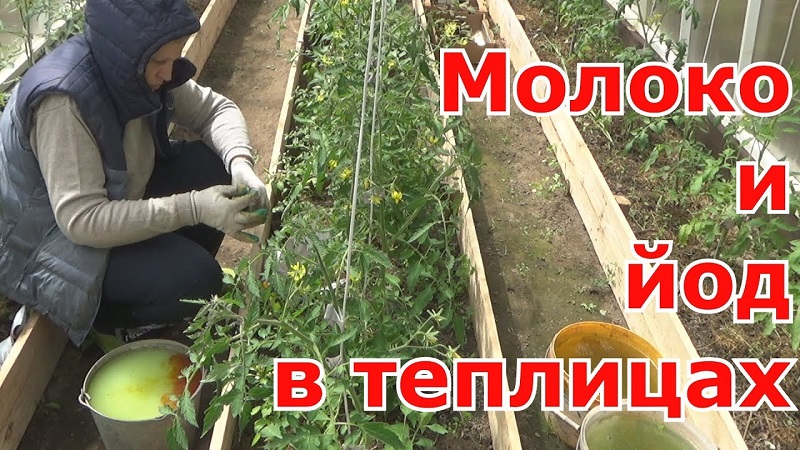
How to prepare a solution
The proportions of the solution depend on the processing method. For the first time, tomatoes are fertilized with less milk and iodine. The solution for root and foliar feeding is prepared in different ways.
Proportions and procedure
To prepare a solution, it is necessary to liquidate the boron crystals. To do this, one tablespoon of crystals is placed in a liter of hot water at 50 ° C. Milk and iodine are added when the boron dissolves and the water cools.
Recipe for a solution for early root feeding
Dissolve 0.5 liters of sour milk, 2 ml of iodine, 10 g of boric acid in a bucket of water. Seedlings are fertilized immediately after planting in open ground, watered at the root by 0.5 liters per bush. Then fertilize when buds form and green fruits appear. The amount of milk for the solution is increased to one liter.
Root fertilizer recipe
Foliar dressing is carried out when the leaves of the bushes curl or become pale green. For this, a solution is made. Based on a liter of water, take 1 gram of boron, a liter of fresh milk, 3 drops of iodine. Tomatoes are processed every week until the result is obtained.
How much and how to store the finished solution
Organic preparations used in horticulture are applied immediately after preparation. The moment the ingredients are mixed, a chemical reaction takes place. A solution of milk with iodine and boron is used immediately after preparation, it is not recommended to store it.

Spraying technology
To achieve the desired result, follow the rules of agricultural technology.
In the greenhouse
Tomatoes that grow in a greenhouse need less root feeding. Provide fertile soil with a one-time feed after transplanting.
Features of using the solution in the greenhouse:
- During processing, you need to ventilate greenhouse.
- Do foliar dressing three times a season, the last time at the stage of green fruits.
- Apply fertilizer to the root once.
In the open field
Tomatoes that grow in the open field are at a greater risk of getting sick. A solution of milk with iodine and boron will help the gardener.
The specificity of using the solution in the open field:
- The first solution treatment is performed after transplanting into the ground. This is prevention against pests and diseases.
- Root feeding is carried out three times a season: after planting the seedlings, when the buds are formed, the first fruits appear.
- Foliar dressing is done as needed - when yellowing and swirling leaves appear.
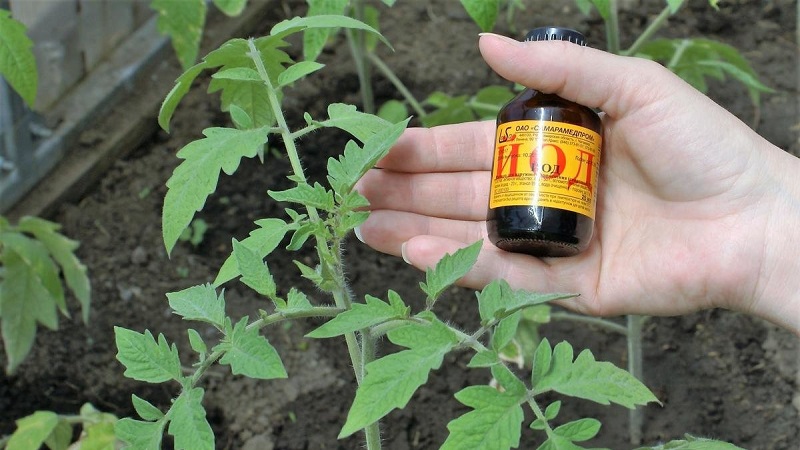
Precautions
A solution with boric acid is used with caution, since boron is a toxic substance. In small doses, boron is harmless to humans.
When processing plants with a solution with boric acid, observe the safety rules:
- work in closed clothing, use gloves, a mask;
- wash hands thoroughly after work;
- do not store the packaging with boron near fire, as it is highly flammable;
- do not let the solution get into the eyes;
- use a mask so as not to inhale boron powder particles;
- after use, remove the remaining solution.
Tips & Tricks
A solution of boron, milk and iodine is prepared according to the following rules:
- Iodine is diluted in warm water.
- Do not use an iron container to dilute liquid.
- For better absorption of the product, you need to spray the tomatoes in the evening.
- Fertilize after watering.
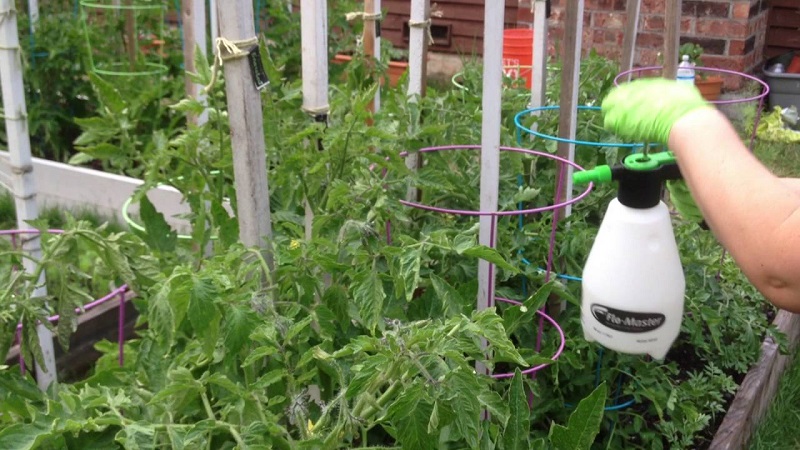
The use of the solution for preventive purposes
The use of milk, iodine and boric acid in gardening helps to get rid of the problem before it appears.
The plantation is treated with a solution: liter of milk, 20 drops of iodine, 2 g of boron in a bucket of water. This will protect tomatoes from fungal diseases and pests.
Reviews of experienced gardeners
Svetlana: “I have been using a mixture of milk, iodine, boron in the garden for many years. I process all plants. It helps tomatoes, blooms better, ripens faster. The fruits taste good, lie and do not spoil. "
Timofey: “The neighbors recommended processing the tomatoes with a solution of milk with iodine and boron. The result was surprising. The vegetable became less sick, the ovaries increased. The harvest was abundant. I advise everyone to try this wonderful remedy in their garden. "
Maria: “My grandmother used milk and iodine for pest control and fertilized tomatoes with boric acid. She had more harvest in her garden than others. "
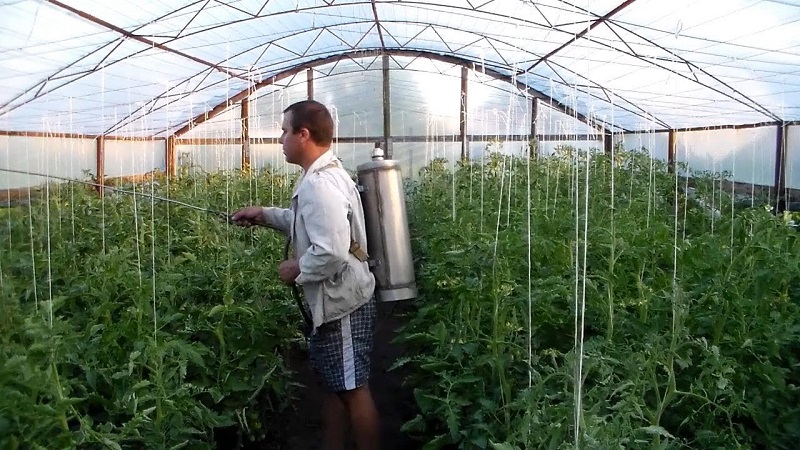
Conclusion
Processing tomatoes with boric acid with iodine and milk is unique. It helps to grow an environmentally friendly product. Tomatoes grow healthy, give a bountiful harvest, and have a long shelf life. The ingredients are sold inexpensively in pharmacies and city shops.
It is important to remember that boron and iodine have a toxic effect on plants if the dosage is exceeded. Most iodine solutions require a few drops, and boric acid - no more than 10 g. Compliance with this simple rule will save plants from poisoning and help them grow better.